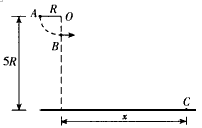问题
计算题
如图所示,一对杂技演员(都视为质点)乘秋千(秋千绳处于水平位置)从A点由静止出发绕O点下摆,当摆到最低点B时,女演员在极短时间内将男演员沿水平方向推出,然后自己刚好能回到高处A。求男演员落地点C与O点的水平距离x。已知男演员质量m1和女演员质量m2之比 ,秋千的质量不计,秋千的摆长为R,C点比O点低5R。
,秋千的质量不计,秋千的摆长为R,C点比O点低5R。

答案
解:设分离前男女演员在秋千最低点B的速度为v0,由机械能守恒定律有

设刚分离时男演员速度的大小为v1,方向与v0相同;女演员速度的大小为v2,方向与v0相反,由动量守恒定律有
(m1+m2)v0=m1v1-m2v2
分离后,男演员做平抛运动,设男演员从被推出到落在C点所需的时间为t,根据题给条件,由运动学规律得4R=
根据题给条件,女演员刚好回到以A点,由机械能守恒定律得
已知m1=2m2,由以上各式可得x=8R

